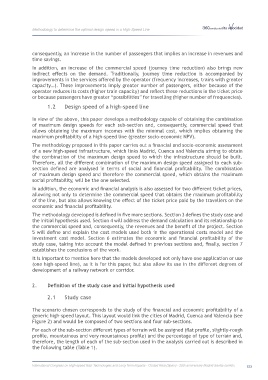Page 535 - 360.revista de Alta Velocidad - Nº 6
P. 535
Methodology to determine the optimal design speed in a High-Speed Line
consequently, an increase in the number of passengers that implies an increase in revenues and
time savings.
In addition, an increase of the commercial speed (journey time reduction) also brings new
indirect effects on the demand. Traditionally, journey time reduction is accompanied by
improvements in the services offered by the operator (frequency increases, trains with greater
capacity…). These improvements imply greater number of passengers, either because of the
operator reduces its costs (higher train capacity) and reflect these reductions in the ticket price
or because passengers have greater “possibilities” for travelling (higher number of frequencies).
1.2 Design speed of a high-speed line
In view of the above, this paper develops a methodology capable of obtaining the combination
of maximum design speeds for each sub-section and, consequently, commercial speed that
allows obtaining the maximum incomes with the minimal cost, which implies obtaining the
maximum profitability of a high-speed line (greater socio-economic NPV).
The methodology proposed in this paper carries out a financial and socio-economic assessment
of a new high-speed infrastructure, which links Madrid, Cuenca and Valencia aiming to obtain
the combination of the maximum design speed to which the infrastructure should be built.
Therefore, all the different combination of the maximum design speed assigned to each sub-
section defined are analysed in terms of social and financial profitability. The combination
of maximum design speed and therefore the commercial speed, which obtains the maximum
social profitability, will be the one selected.
In addition, the economic and financial analysis is also assessed for two different ticket prices,
allowing not only to determine the commercial speed that obtains the maximum profitability
of the line, but also allows knowing the effect of the ticket price paid by the travellers on the
economic and financial profitability.
The methodology developed is defined in five more sections. Section 3 defines the study case and
the initial hypothesis used. Section 4 will address the demand calculation and its relationship to
the commercial speed and, consequently, the revenues and the benefit of the project. Section
5 will define and explain the cost models used both in the operational costs model and the
investment cost model. Section 6 estimates the economic and financial profitability of the
study case, taking into account the model defined in previous sections and, finally, section 7
establishes the conclusions of the work.
It is important to mention here that the models developed not only have one application or use
(one high-speed line), as it is for this paper, but also allow its use in the different degrees of
development of a railway network or corridor.
2. Definition of the study case and initial hypothesis used
2.1 Study case
The scenario chosen corresponds to the study of the financial and economic profitability of a
generic high-speed layout. This layout would link the cities of Madrid, Cuenca and Valencia (see
Figure 2) and would be composed of two sections and four sub-sections.
For each of the sub-section different types of terrain will be assigned (flat profile, slightly-rough
profile, mountainous and very mountainous profile) and the percentage of type of terrain and,
therefore, the length of each of the sub-section used in the analysis carried out is described in
the following table (Table 1).
International Congress on High-speed Rail: Technologies and Long Term Impacts - Ciudad Real (Spain) - 25th anniversary Madrid-Sevilla corridor 533

